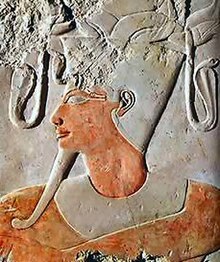Egyptian Invasion of Kerma
| The Ancient Egyptian invasion of Kerma | |||||||
|---|---|---|---|---|---|---|---|
 | |||||||
| |||||||
| Belligerents | |||||||
| New Kingdom of Egypt | Kerma | ||||||
Between 1575 and 1550 BC, the Kerma Kingdom posed a major threat to Ancient Egypt.[1][2] According to inscriptions from tomb of Egyptian governor Sobeknakht II at Nekheb, Kerma forces invaded deep into Egyptian territory during this period.[3][4][5] In 1504 BC, Thutmose I saw the need to counter this growing danger and obtain Nubia’s rich resources, especially gold.[6]
Ancient Egyptian advance to the south
[edit]Thutmose I led his army south to a rocky mountain named Jebel Barkal. This location was very important both militarily and religiously; it was thought by the priests of the Temple of Amun to be the birthplace of the god Amun. This would further justify the invasion, linking religious motives with military goals.[7] Jebel Barkal was rich in gold and other valuable resources, making seizing it important for Egypt's wealth and power.[8]
Reasons for the invasion
[edit]When Egypt was experiencing internal turmoil and wars during the reign of the Hyksos in Lower Egypt, the Kerma Kingdom took advantage and expanded into Egyptian territory, even invading as far as Thebes, which was one of Egypt's most important cities. After Ahmose I defeated the Hyksos in the northeastern Nile Delta, he launched military campaigns against Kerma, leading to several confrontations that eventually ended in Nubia falling under Egyptian control. During the reign of Amenhotep I, military effort continued beyond Egypt's borders, deep into Nubia expanding Egyptian control as far south as the Third cataract of the Nile. Later, Thutmose I further extended Ancient Egyptian influence into Nubia, asserting control over the whole of the Kerma Kingdom. His military campaigns helped solidify Ancient Egyptian dominance, some records show that he went as far as Kanisah Kurgus beyond the Fourth Cataract.[9][10]
References
[edit]- ^ Grajetzki, Wolfram (2006-02-24). The Middle Kingdom of Ancient Egypt: History, Archaeology and Society. Bloomsbury Academic. ISBN 978-0-7156-3435-6.
- ^ "Archaeology and Geography". The Middle Kingdom of Ancient Egypt: 85–156. 2024. doi:10.5040/9781350455573.ch-002. ISBN 978-1-350-45557-3.
- ^ Shaw, Ian (2003-10-23). The Oxford History of Ancient Egypt. OUP Oxford. ISBN 978-0-19-160462-1.
- ^ Shaw, Ian, ed. (2000-08-31). The Oxford History Of Ancient Egypt. Oxford University PressOxford. doi:10.1093/oso/9780198150343.001.0001. ISBN 978-0-19-815034-3.
- ^ Lloyd, Alan B. (1994-10-13), "Egypt, 404–332 B.C.", The Cambridge Ancient History, Cambridge University Press, pp. 337–360, doi:10.1017/chol9780521233484.013, ISBN 978-1-139-05433-1, retrieved 2024-09-29
- ^ Jarus, Owen (2017-02-14). "Ancient Nubia: A Brief History". livescience.com. Retrieved 2021-10-26.
- ^ Lloyd, Alan B. (1994-10-13), "Egypt, 404–332 B.C.", The Cambridge Ancient History, Cambridge University Press, pp. 337–360, doi:10.1017/chol9780521233484.013, ISBN 978-1-139-05433-1, retrieved 2024-09-29
- ^ Kim, C; Kim, A (2013-12-15). "Abstract P4-06-02: Changes in intrinsic subtype of breast cancer during tumor progression in same patient". Cancer Research. 73 (24_Supplement): P4–06-02-P4-06-02. doi:10.1158/0008-5472.sabcs13-p4-06-02. ISSN 0008-5472.
- ^ "The Kingdom of Kush - Ancient History Encyclopedia". 2020-03-31. Archived from the original on 2020-03-31. Retrieved 2021-10-26.
- ^ "Interrelations of Kerma and Pharaonic Egypt - World History Encyclopedia". 2021-08-24. Archived from the original on 2021-08-24. Retrieved 2021-10-26.
